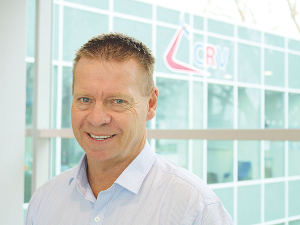Fewer bobby calves as dairy farmers shift to beef breeding
Fewer bobby calves are heading to the works this season, as more dairy farmers recognise the value of rearing calves for beef.
 CRV herd testing manager Mark Redgate says many farmers may still not realise the value of herd testing.
CRV herd testing manager Mark Redgate says many farmers may still not realise the value of herd testing.
Some dairy farmers could be missing out on up to 160 kgMS of production because they are not herd testing.
That’s according to CRV herd testing manager Mark Redgate.
While the number of cows being herd tested jumped by 1.2% last season, many farmers may still not realise its value.
Redgate wants that to change.
For some dairy farmers, herd testing can be another job to add to the list. They may not see the upsides. More specifically, they may not see how the expense of herd testing could make them enough money to justify the financial and labour costs of getting it done.
Redgate says he understands the rationale.
“I wouldn’t spend money on things that don’t improve my profit. But making money is the result of making enough of the right decisions,” he says.
“That’s what herd testing is all about – giving farmers the kind of information from which they can make better moneymaking calls.
“The other thing to remember is that some key information and insights are hidden. You can’t know what’s really going on with an individual animal without this kind of testing.”
160 kgMS is a stat Redgate likes to talk about with farmers. 160 kgMS per year is the production difference between the top 20% of a farmer’s cows and the bottom 20%. That represents a big gap in revenue between these two groups of animals.
It makes financial sense to know which cows are in the top 20%. You breed from these animals to increase the productivity of your herd, points out Redgate.
Knowing which cows are in the bottom 20% can also be profitable. The worst performers can be culled or bred for dairy beef, while animals with genetic potential can be inseminated with sexed semen or targeted with specific traits to boost the productivity potential of their progeny.
Redgate says when he talks about identifying the top and bottom performers, many farmers feel confident they know their cows.
There’s no denying farmers observe their animals every day. They watch their cows’ behaviour and can see who the best producers are, he says.
But he adds that unfortunately, looks can be deceiving.
“Take the cow with high milk volume. Her quantities suggest she’s a good money earner, but farmers are not paid strictly by volume; they’re paid on milk fat and milk protein, neither of which can be discerned with the naked eye.
“But a test of 30ml of milk from that cow will reveal the exact composition of her milk and the true profitability of that animal.
“Farmers are often surprised at how best and worst performers are reordered after a herd test.
“The same is true for animal health. We’ve tested herds and discovered cows that they were carrying mastitis but were asymptomatic. That means these cows weren’t going down sick themselves but were happily spreading mastitis throughout the herd.
“There’s no way to detect that visually. But we can spot a dangerous somatic cell count from that 30ml test of milk.
“By capturing your herd test results in myHERD, you can interpret and link the data to help you make better decisions.”
Add to your 'To Do' List
Mark Redgate says he understands that farmers are constantly battling an endless list of things to do.
“They’ve got cows that are empty, and animals struggling with eczema.
“The idea of spending money on a herd test seems more trouble than it’s worth, especially if that test might lead to the culling of animals. But this is precisely where a herd test shines.
“In a herd’s bottom 20%, there are animals that will continually drain resources and cost farmers money.
“But there are also animals in that lower 20 with the genetic potential to be among a farmer’s best performers. Based on milking stats alone, they look the same. So which ones are which? Herd testing will tell us.
Three New Zealand agritech companies are set to join forces to help unlock the full potential of technology.
As the sector heads into the traditional peak period for injuries and fatalities, farmers are being urged to "take a moment".
Federated Farmers says almost 2000 farmers have signed a petition launched this month to urge the Government to step in and provide certainty while the badly broken resource consent system is fixed.
Zespri’s counter-seasonal Zespri Global Supply (ZGS) programme is underway with approximately 33 million trays, or 118,800 tonnes, expected this year from orchards throughout France, Italy, Greece, Korea, and Japan.
Animal owners can help protect life-saving antibiotics from resistant bacteria by keeping their animals healthy, says the New Zealand Veterinary Association.
According to analysis by the Meat Industry Association (MIA), New Zealand red meat exports reached $827 million in October, a 27% increase on the same period last year.
OPINION: Dipping global dairy prices have already resulted in Irish farmers facing a price cut from processors.
OPINION: Are the heydays of soaring global demand for butter over?